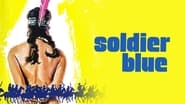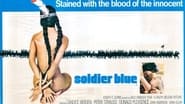Zachary Jean
"No! No! Don't shoot, there's a white woman down there!" (actual line)This is another, in a long line, of movies that gives lip-service to the plight of the Native American in their movie posters (in this case by showing them all getting butchered) but fails to actually include a single Indigenous actor or get history correct. We're told that these are Cheyenne and that this is Sand Creek, but don't start looking around for Chief Black Kettle or the Arapaho because what's more important than historical accuracy is a romantic comedy between two bumbling white people.Was there ever a time when a young man, tied and bound and fighting for his life, spent more energy attempting to use his teeth to pull Candice Bergen's skirt back down over her bottom (twice) so that when he finally got around to untying her hands he wasn't confronted with (gasp!) naked female flesh? Peter Strauss plays said young man, Honus Gant, and the best you can say about Grant is that he's completely useless. In theory he is suppose to be in the U.S. Cavalry, but that implies some level of skill and instead we're treated with a neutered fop who, when he isn't flailing comically around in the underbrush, is making rude "girls are icky" remarks to Bergen, because it's the 70s and apparently audiences loved their leading men emasculated and chauvinistic in equal measures. I was born in 1970, the year this movie came out, and while I know about My Lai whatever emotional impact Ralph Nelson was able to make at the time by connecting this movie with that atrocity has long been lost. Indeed, emotionally, if you actually want to know about what happened at the Sand Creek massacre, I suggest reading, "Bury My Heart At Wounded Knee," by Dee Brown, which also came out the same year as this movie and puts Nelson to shame. But if you're more interested in watching Candice Bergen belch and do her "Ugh! Pale Face!" routine, then Soldier Blue is the movie for you!
weezeralfalfa
One of several westerns in the '60s and '70s that dramatized the injustices and atrocities committed against the Cheyenne, often by much superior US military forces. Other notable films include the more humorous, if nearly as bloody, "Little Big Man", and John Ford's previous epic "Cheyenne Autumn". Whereas Ford's film ends on an optimistic note for both the Cheyenne and their European advocates, these 2 later films, released during the height of the Vietnam War, are pessimistic, regarding both the Cheyenne and their European advocates. This film is notable for its shockingly graphic portrayal of the Sand Creek massacre. However, it takes a one-sided view of Cheyenne-European conflict.This story is an all around tragedy, perhaps meant to mirror the common perception of the time that the war in Vietnam was an unnecessary tragedy for many. Not only is a peaceful Cheyenne village, mostly consisting of women and children, savagely wiped out, the romantic couple we have been following for most of the film are left in a state of limbo. Cresta, confused about her identity as either a captured Cheyenne wife or a repatriated European, is left being escorted, along with Cheyenne survivors, by the cavalry. Meanwhile, Honus, the once duty-bound cavalry private whom she has turned into a protester of his commanding officer's annihilation policy, is chained to a cavalry supply wagon, being taken home for court- martialling.As pointed out by another reviewer, this film is based on a blend of Olsen's fictional writing "Arrow in this Sun", and the historic massacre. Unfortunately, the screen writer didn't adjust the historic timing of the novel-based portion to fit the historical timing of the massacre, which occurred in 1864, during the Civil War. Two clues indicate that this story supposedly takes place in '77. Honus tells Cresta that his father was killed a year ago in Custer's Last Stand, which occurred in '76. Also, the US flag that the Cheyenne village displayed has 38 stars, correct for '76, but 3 more than in '64. This discrepancy could have easily been eliminated.The actual massacre was perpetrated by Colorado Territory militia, responding to demands to do something to stop the depredations the militaristic wing of the Cheyenne, called dog soldiers(featured in part of Ford's "She Wore a Yellow Ribbon"). Instead, Colonel Chivington attacked a vulnerable, easily located, peaceful Cheyenne village, despite their raising of the American flag and a white flag of truce, as dramatized in the film. Instead of Colorado militia, regular US cavalry are portrayed(They should have been fighting Johnny Reb!), and Chivington's name was altered to Iverson. In addition to depredations on the European civilian population, Iverson justifies his action as retaliation for the slaughter of the payroll wagon escort: a fictional complication derived from Olsen's novel(and previously portrayed in "She Wore a Yellow Ribbon"). In the film, Spotted Wolf is characterized as both leading the attack on the payroll wagon to obtain money to buy rifles, and later deciding on a peaceful surrender to the cavalry, since the rifles we was expecting were discovered and destroyed by Honus. Total fiction.As in several other films dealing with European captives of 'Indians', Cresta has a severe identity crisis. Should she try to resume her recent life as a wife of Chief Spotted Wolf, or consummate her long interrupted romance with horny Lt. McNair, stationed at Fort Reunion, or take up with seemingly unpromising, but gentlemanly, private Honus, with whom she is presently stranded? This sassy foul-mouthed former NYC orphan seems willing to take advantage of whatever opportunity seems most promising. In the end, all 3 of these options are obsolete.Cresta's time spent with the Cheyenne has made her a savvy survivor in this plains wilderness. Honus, in contrast, seems not very savvy about surviving here on his own, as well as reluctant to kill 'Indians'. This creates periodic humor and conflict. When they are discovered by a detachment of Pawnees, she tells Honus he must wrestle with the chief, to have a chance of saving their lives. Honus gets the better of the chief, but is afraid to kill him, which the chief's companions do, since he has shamed his tribe in not defeating Honus. Against Cresta's wishes, he torches the rifles destined for the Cheyenne, illegally peddled by loner Q. Cumber. Later, Honus regrets this decision when he learns of Iverson's plan to destroy the Cheyenne village Cresta has run to. Cumber holds them hostage until they manage to escape and hide in a cave, where Cresta tends Honus's gunshot wound from Cumber. .. They gradually warm up to each other during these trials, until Cresta decides to go it alone to Ft. Reunion to get help for Honus. Cresta is chagrinned that Iverson refuses to allow just a couple of his 700 man force to help retrieve Honus. Thus, she steals a horse and rides to the Cheyenne village to warn them of the impending attack. Meanwhile , Honus wanders from the cave and, serendipitously, discovers a stray domesticated horse(Cumber's?), to get him back into the action, just before the attack on the Cheyenne.
Gross Ryder
This movie, made twenty years after "Broken Arrow", by which time the tide had turned against deception and towards truth insofar as Hollywood is concerned, had a shocking impact upon the audiences or at least those who had the guts to go see it even after knowing what the movie was about. Those who didn't want to see the dark and horrible side of American History, those who had their minds made up and hearts hardened by racism or nationalism, were in denial and didn't bother to see it or dismissed it as exaggerated and one sided. Earlier I was not keen on Western genre movies, and this was the first movie that I had seen until then (this was around 1975, I had not yet seen earlier movies like "Broken arrow") about Indian and White relations depicted explicitly and it came as quite a shocker - a bolt from the blue and I wondered - how come I had never heard about, known about, come across such events in History that were crucial for race and cultural relations? And that is because I was a Technology buff, an engineering student. And History of race/cultural relations were of little interest to me at that time, all I cared about was the latest technological developments taking place. As humans, we notice only things that interest or attract us, and even the most profound tragedy escapes our notice, unless one is acutely aware and sensitive to such things. Only as a victim of a tragic event does this awareness become acute. As a perpetrator or participant, we work overtime to justify and cover up such crimes, as if we have no choice in the matter and that it happened as a consequence of earlier events and so on. We build elaborate stories of justifications for our actions, always assuming that we could have done no wrong, and at worst our hand was forced by the chain of events, forced by the victims themselves. But this movie jolted me out of my typical complacent attitude that such things happened because the march of civilization was a necessity for Science and Technology to develop, and the savages were the impediment to this progress towards the Technological utopia. This movie disturbed me profoundly, and I realized that it had upset the dream that modern civilizations had built and taught to me and to each of its children - that Scientific progress and its application in Technology were ultimate human goals, and that issues like 'justice' and ideas like 'humanity' were puny, inconsequential and trivial before the latest machine or gizmo that we were infatuated with. What was merely a means had become an end in itself. And just what is the end of Science and Technology, I have yet to come across anyone who has even made a proposition. I then became more and more aware of racial, cultural issues and conflicts, and thereafter whenever I got a chance to know more about the past and about alternative cultures, I took it, and it kept on growing like the snowball in an avalanche.....
euricosilvestre
I first saw Soldier Blue some thirty five years ago, in a cheap exploitation theatre, and i was perhaps as shocked as the makers intended. I have distinct memories of leaving the theatre with an unpleasant taste in my mouth. Here was a film that not only didn't fear the displaying of extreme graphic violence, but indeed used it to the point of being exploitative.Perhaps some of the musical score, or the paralels with the Vietnam war are now dated, but generally it remains a powerful film that also makes you think.It is at this point that i must diverge with the great majority of the reviews here. Sometimes it seems like i have watched an entirely different film, for the film shows bluntly and brutally that the Native Americans were also capable of massacres or gang rapes, for instance. Not that it justifies genocide, but it is true nevertheless. They are not portrayed as the noble savages, that most people now like to consider them.Take the case of the Comanches, for instance. They came to the Southern plains from the north, and displaced and almost completely exterminated the plains Apaches. For two hundred years they raided Northern Mexico, and committed genocide over the population. The point is that seeing Native Americans merely as victims does not respect the historical truth. A film such as this one can make people see the bigger picture, and stop trying to rewrite History.



















